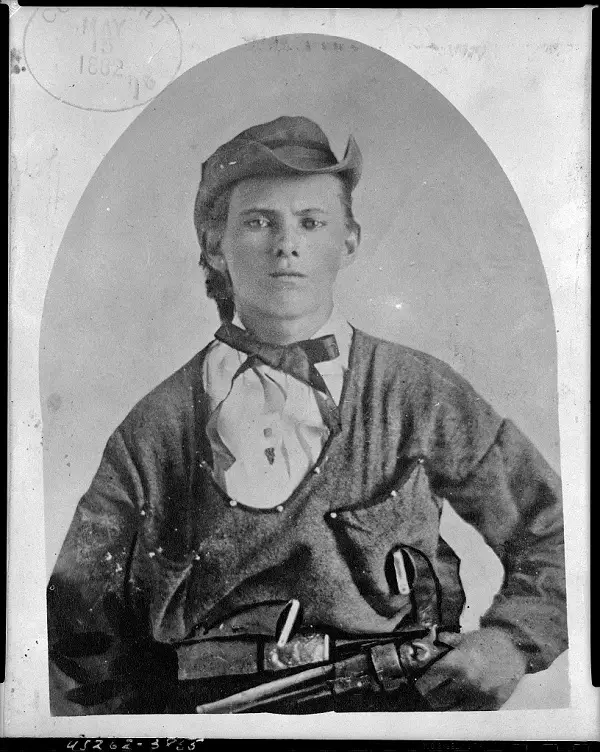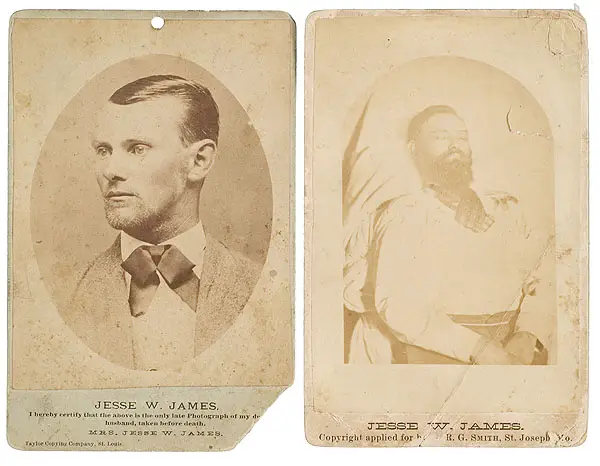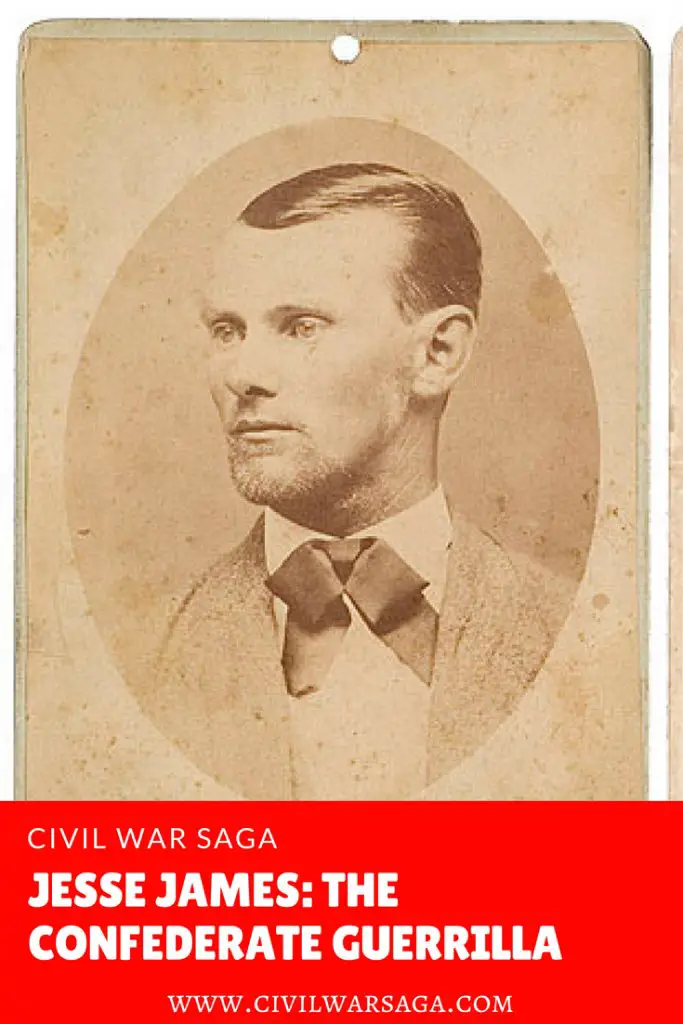Jesse James, one of the most violent outlaws of the wild west, got his first taste for violence as a Civil War guerrilla fighting for the Confederates.
Although he came to be known as one of the most dangerous bandits of the west, James started out his life as a religious, peaceful farm boy who seemed destined for a career as a minister, like his father Robert, who died in California while preaching to gold miners.
Those plans changed when the Civil War broke out in 1861 and brought chaos to his sleepy hometown of Kearney, Missouri.
As slave owners with six slaves working on the family hemp farm, the James family sympathized with the Confederate cause.
Born in 1847, Jesse was too young to join the army and begrudgingly stayed behind as he watched his older brother Frank leave home and join a group of Confederate guerrillas known as Quantrill’s Raiders, run by outlaw William Quantrill.
The war soon came home to Jesse when his brother’s activities in the gang led the Union army to the James farm. Looking for information on Frank’s whereabouts, the soldiers beat Jesse and tortured his stepfather.
Historians believe this violent experience is what pushed Jesse to join his brother and the gang, at just 16 years old, in the spring of 1864.

Led by “Bloody Bill” Anderson, the gang was made up mostly of wealthy, slave owning families seeking to protect Missouri from the anti-slavery Union ideals. They terrorized anyone who sympathized with or supported the Union army in Missouri.
During a raid in the summer of 1864, Jesse was shot in the chest but recovered in time to take part in one of the bloodiest atrocities of the Civil War: The Centralia Massacre.
Described by witnesses as a “carnival of blood,” the Centralia Massacre was a raid on the small Missouri town of Centralia.
While the gang was looting the town and murdering anyone who protested, a train pulled into the center of town with 21 unarmed Union soldiers on leave from the army.
Anderson and his men quickly stripped the soldiers of their clothing, so they could use them as disguises, and shot them dead.
Nearby Union troops caught wind of the violence and headed toward the town to put an end to it. The gang set up an ambush, captured and then killed all 150 soldiers. Jesse himself was credited with killing Union major A.V. E. Johnson in the massacre.
Many of the soldiers were beheaded, disemboweled and slowly tortured. After the violence was over, the gang then proceeded to mutilate and scalp the bodies.
Anderson died a few weeks later after he was killed by members of the Missouri State Militia and most of the gang returned to quiet civilian life after the Civil War ended, except for Jesse and his brother.
Still angry over the defeat of the Confederate army, the brothers vowed to continue fighting. The James brothers teamed up with the Younger brothers and several other outlaws and formed the James-Younger gang.
The gang began robbing banks, including a bank owned by the man they believed killed Anderson, and murdered him on the spot.
When the press mentioned Jesse by name it gave him a thrill and spurred him to continue. Jesse acquired his own gang and together they robbed banks, trains and stagecoaches while declaring themselves heroic Southern fighters:
“We are not thieves,” he wrote in a letter to a newspaper, “we are bold robbers. I am proud of the name, for Alexander the Great was a bold robber, and Julius Caesar, and Napoleon Bonaparte.”
On April 23, 1874, Jesse James married his first cousin Zerelda Amanda Mimms in Kansas City, Missouri.
James continued robbing banks and eventually ran into trouble after a robbery in Minnesota in the summer of 1876 turned deadly and two members of the gang were killed.
The James brothers went into hiding but Jesse eventually became restless and started another gang. Jesse met his end when two men in his group, Charley and Bob Ford, decided to kill Jesse hoping to collect the reward Governor Crittenden had placed on Jesse’s head.

Robert Ford killed Jesse James on April 3, 1882 by shooting him in the head when his back was turned. The Ford brothers later stood trial for murder but were pardoned by the governor.
If you want to learn more about Jesse James, check out this article on the best books about Jesse James and this timeline of Jesse James’ life.

Sources:
Settle, William A. Jesse James Was His Name. University of Missouri Press, 1966
Shafer, Amy. “Visitors Drawn to Jesse James’ Hometown.” Deseret News, 23 July. 2000: deseretnews.com/article/772331/Visitors-drawn-to-Jesse-James-hometown.html
“Guerilla Tactics.” PBS, pbs.org/wgbh/americanexperience/features/interview/james-guerrilla/
“Jesse James (1847 – 1882).” The State Historical Society of Missouri, shs.umsystem.edu/famousmissourians/folklegends/james/
McPherson, James A. “How the Civil War Shaped Jesse James.” US News, 24 June. 2007, usnews.com/news/articles/2007/06/24/how-the-civil-war-shaped-jesse-james

Anything Bloody Bill Anderson did, the Kansas Redlegs did also.
Slavery being legal under color of law, Kansas freebooters had no business attacking Confederate sympathizers just for the sake of a belief; and that’s all it amounted to. Quantrell and Anderson fought back.
You are correct.
“…had no business…” Oh please, no Confederate sympathizers. The war is over and it was a terrible, embarrassing event. Brother killing brother over the “rights of slave-owners” is an abomination. It should never have happened. When people support the Confederate cause on public spaces like this, they are reflecting the racist viewpoint that permeated the South during this time and it seems as if these Confederate supporters want to return to the slave-holding days. Just don’t go there–just walk away. America doesn’t need staunch racism and persecution to rear its ugly head again.
History is history,whether you like it or not,it wont just go away.A Nazi in a Catholic Church bell tower,blew my Dads’ left arm off,BUT,forgetting about Nazis,World War 2,and Catholic Churches,are NOT,going to bring Private Robert Harfords left arm back.
Our past as a country is exactly that….our past, it should be left there to study and learn from. The sad part is that people cherry pick what they want to know and learn sometimes; keep an open mind when you study the past, learn to ask questions about all things.
People of that time (pre-Civil War/Civil War & Post) fought for their beliefs (both sides), a way of life in slave states was being threatened by a fairly new government that was trying to rectify and improve the laws we ALL would live by. Looking back, it’s easy for me to say that slavery was a necessary evil to start this wonderful thing we now call the United States of America, but at the same time it was horrible that it survived OUR Declaration of Independence. People of all colors and religions/non-religious fought to start this great experiment we call democracy here in America.
The one thing that many people overlook is that slavery wasn’t an American idea, it was brought here and instituted under British and French rule to feed the growing need of agriculture in America. Yes, slavery survived independence, but it was corrected in over the next 85 years….considering this evil has been around since recorded history just about started, that makes me proud to say I’m a citizen of the United States of America.
Learn from the past everyone, but do it in a way that improves the world around us…for everyone.
Was it corrected ? Black people are still being marginalized, sterotyped, disrespected and criminalized. We have to worry about the people who vowed to serve and protect us killing us in front of witnesses. 99% of the time they escape prosecution. I am raising a black son and I can assure you it has not been corrected. It is illegal on paper at best. The United States you speak of does not exist for people who look like me. Regardless of the history we still have a long way to go. Justice means Just us in the United states. Where is the correction in that?
Why is that Merry smith it can be published
“… Yes, slavery survived independence, but it was corrected in over the next 85 years….considering this evil has been around since recorded history just about started, that makes me proud to say I’m a citizen of the United States of America.
Learn from the past everyone, but do it in a way that improves the world around us…for everyone.”
Do you truly and honestly believe it has been corrected ? Not even close. Racism still exists and rages on. We as Americans have still yet to learn ALL MEN ARE CREATED EQUAL. Heck women are still not seen as equal to the white man.